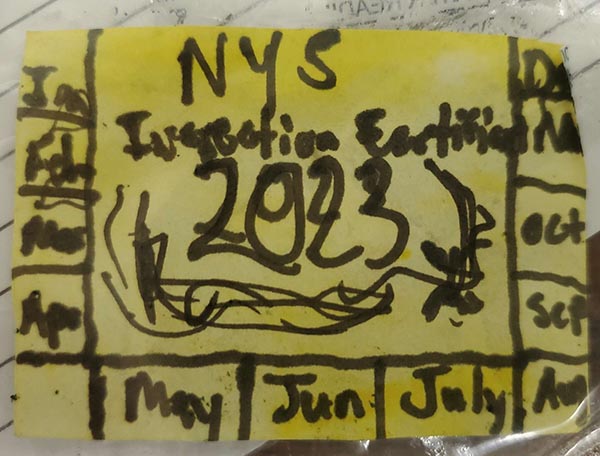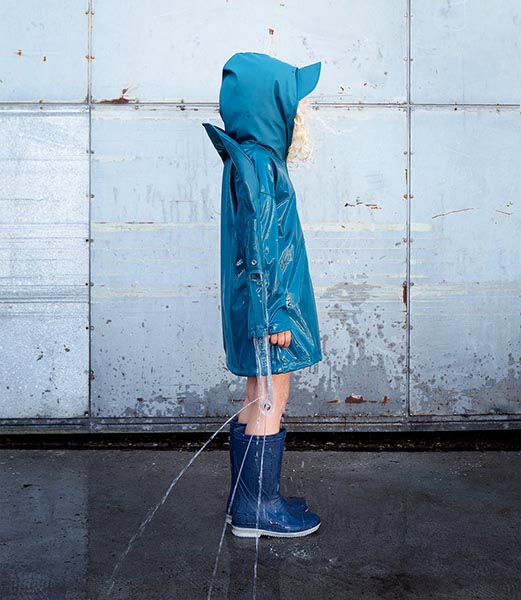Your Friday Acoustic Guitar Self-Playing Robot
Test Testing
First up this week, an Around the Web public service announcement.
If you got your free COVID-19 test(s) from COVIDTests.gov (or some other source), they may have expired, which can result in various components of the test degrading or breaking down and thus yielding inaccurate results. However, as with foods, expiration dates may not be accurate. Says CNET:
After a COVID-19 test has been approved and in use for a year or more, the manufacturer can use its data to ask the Food and Drug Administration to extend its shelf life. Of the 22 at-home COVID-19 tests listed on the FDA website, nine of them have had their shelf lives extended since they were released, including iHealth, one of the more common at-home test providers in early free shipments.
So if your test kit packaging indicates a past expiration date, before you chuck it, check the FDA list of extended expiration dates to see if it you can still get a few more tests out of it. For example, down here in the Around the Web Cultural Accretion Bunker, we still have an unused CareStart COVID-19 Antigen Home Test from AccessBio. The box indicates an expiration date of March 2022, but back in May, that expiration was extended to September 2022.

If your cache of home tests is on the list, it might be worthwhile to hang onto them, but be sure not to use them until they get the all-clear.
Sticker Shock
Now, as graphic communications professionals, we have problems not with the idea here, but rather with the execution. From the (Albany) Times Union:
It seems unlikely that a state trooper needed a second opinion before charging a man with having a forged inspection sticker on the vehicle he was driving Tuesday.
The alleged fake found on a vehicle driven by a 30-year-old Johnstown man appeared to be made by someone who took Magic Marker to a Post-It Note. The crude lettering is difficult to read.

Come on! In this age of Google Images and cheap desktop color printing, this is the best a would-be forger can do? And this is not the only example of cheap, hand-drawn faux inspection stickers—there have been nearly half a dozen others caught during traffic stops in the Capital District alone.
In January, Mechanicville police posted a more carefully hand-drawn fake inspection sticker that included a tiny, but detailed, state seal next to a sloppy "2022" in Sharpie ink.

Come on!!
Nature Green in Tooth and Claw
We just can’t help but imagine Agatha Christie hanging about this place with a notebook…
Via the BBC, a look at the UK’s deadliest public garden: the Poison Garden at the Alnwick Garden in Northumberland, England, which is home to more than 100 toxic, intoxicating, and narcotic plants. It is indeed open to the public, but attendees are required to attend a safety lecture before they are allowed in.
Visitors are instructed that they're not allowed to touch, taste or smell anything – nevertheless, as the website notes, guests have still occasionally fainted from inhaling toxic fumes as they walk through.
…”Probably the most poisonous plant we actually have here is ricin [which contains the toxin ricin] better known as the castor bean or castor oil plant,” Smith said. “The Guinness Book of World Records considers that to be the world's most poisonous plant.”
Sure, plants can be poisonous if a person (or pet) eats them, but some are more proactively poisonous.
if enough rhododendrons grow near each other, they’ll poison the soil – making it so that the only things that can grow there are other rhododendrons. And if bees gather honey exclusively from rhododendrons, the liquid takes on a red colour and, in small doses, hallucinogenic properties. “But larger doses would be fatal,” he warned.
Great…tripping bees, probably listening to Jefferson Airplane’s After Buzzing at Baxters. Then there is the cherry laurel (or English laurel):
The leaves of the Prunus laurocerasus (also known as the cherry laurel or English laurel) contain two components (cyanogenic glycosides and cyanide ions) that, separately, won't harm you. But if an animal was to mash up the leaves by chewing them – or if a human was to take a hedge cutter to them – they produce cyanide gas.
Still, we’d be curious to take a tour…carefully. It does look inviting!

Have a Drink…or Hundreds
At first glance, we’re not entirely certain what this is or how it works. Via Laughing Squid, Cana One is “an innovative countertop beverage printer that creates hundreds of different customizable drinks on a molecular level using a single recyclable ingredient cartridge and without any wasteful pods or other refill containers.”
“Beverage printer.” OK. From the Cana One site:
Cana scientists identified and isolated the specific trace compounds that drive flavor and aroma for thousands of unique commercially available beverages. They created the world’s first universal beverage ingredient set, which recreates thousands of different drinks using a simplified set of ingredients that can be printed out of a long-lasting ingredient cartridge.
The video sorts things out:
OK, “beverage printer” is a little misleading, but it sounds like it could be a neat idea. One of its ideas is to reduce waste by being able to produce a wide array of flavors using a single cartridge, but the question becomes, what do you do with the cartridge when it runs out? According to the video, “every cartridge can be reused up to 12 times.” Does that mean it only makes 12 beverages per cartridge? Or can you shake it up when it’s low like laser printer toner and get a few more copies out of it? And, as its name implies, can it turn water into wine? And if you use this to serve beverages before a wedding, would it be a Pre-Cana?
Anyway, they are taking reservations for the Cana—there is a $99 reservation fee, plus a cost of $499 for the first 10,000 orders, with the regular price being $799 thereafter. Hmmm… Anyway, if you’re interested, deliveries start in 2023.
But What About Mondays?
Via Core 77, Dutch designer MIRL has launched a project to “celebrate rainy days.” Why?
“We call rainy days bad weather, however, when rainy days occur more often we may have to change that opinion. When the earth warms up by 2 degrees, The Netherlands will face many more moments with heavy persistent rainfall. So why not change the perspective of bad weather for the next generation by celebrating rainy days?”
And how do we do this? Ah, yes: rainwater harvesting clothes. Specifically, a set of raincoats that “come alive” by making “inventive use of rainwater.”
“While collecting, containing and pouring water, the raincoat becomes a wearable playground. One has a fun funnel in the sleeve, another collects water in tubes sewn into the hem, and a third unfolds to form a big receptacle for a carry-on puddle.”

Make sure you have some towels by the front door.
Here’s a better idea. Instead of playing with the water, keep in the coat until there is a dry spell, and then use it to water the garden.
What About Sunny Days?
If the skies clear up and/or harvesting rainwater gets old, when the sun comes out you can harvest sunlight, thanks to this solar-powered beach umbrella from CRA-Carlo Ratti Associati and the Italian dessert company (?) Sammontana: the Parelio. Says Core 77:
It uses foldable, photovoltaic panels to collect sunlight that can then be used for a variety of purposes, including cooling the immediate environment, refrigerating refreshments, charging phones, and powering machinery. Parelio’s attached coolers, sprayers, and refrigeration capabilities make it perfect for providing comfortable seating at restaurants, cafes, or park events.
But why use just one Parelio? Use many of them!
While one umbrella is powerful on its own, a network of Parelios packs an even bigger punch. The product's modular system design allows multiple umbrellas to pool electricity that can provide power for an impressive variety of structures, from ice cream refrigerators to an entire resort. This means increased traffic at bar patios, restaurants, and hotels doesn't have to translate into huge electricity bills, and the accumulated power can even provide a boost of energy during busy nights or off seasons.

You can tell from the plant building that this is Milan, Italy, where a protype Parelio network was tested for eight weeks last summer. “Sustainable nonprofit The Riccardo Catella Foundation helped them install a free public lounge of several umbrellas in BAM Park-Tree Library that provided relief to locals and visitors while simulating the outcomes of single and aggregated setups.” It was apparently quite successful.
Life’s Good with Graphene
Was it a good week for graphene news? It’s always a good week for graphene news! LG Electronics USA is launching its 2022 lineup of graphene-enhanced TONE Free true wireless earbuds. Says Graphene-Info:
The flagship model, TONE Free T90, is said to deliver impressive sound thanks to several upgrades, including the use of graphene to reduce vibration. The use of graphene helps reduce vibration, while Dolby Head Tracking support keeps the feel of music around the users, even when they move.

Look (or listen) for them in September 2022.
Capital Grail
We stumbled across a new (to us) news aggregation site you’ll probably be hearing more of in the future. The Daily Grail compiles “weird news” from around the world, and its daily news briefs alone give one the sense that one is living in a science-fiction film. Some samples from the 08-11-2022 newsfeed (compare it with ours):
- The saga of weird debris on Mars continues: NASA investigates mystery objects on Mars rover Perseverance’s sample system.
- Cultural bias distorts the search for alien life.
- Argentina: School teachers observe and photograph UFO.
- Additional information on the controversial FBI “Hottel memo” describing crashed flying saucers has been uncovered by The Black Vault.
- Midwest Conference on the Unknown provides space for thorough conversation.
- Spiders may be able to dream, according to scientists.
- Scientists invent ‘quantum Pied Piper’ that can make particles of light move together.
- The ‘NESARA’ conspiracy theory about ‘new world order’ won’t save Vancouver home from foreclosure, judge rules.
- If you want to learn more about NESARA –a.k.a. Saint Germain’s infinite money cheat code– you should listen to this episode of The Nonsense Bazaar.
- The devils are loose to celebrate the cultural heritage of Mexico’s indigenous groups.
- Red Pill of the Day: When you piss off the local weather witches.
Any one of these are worth clicking through. Especially…
Dream Weavers
We were way ahead of The Daily Grail as we had bookmarked this story for Around the Web before we stumbled onto Daily Grail. Via Scientific American, behavioral ecologist Daniela C. Rößler had collected a batch of jumping spiders, intending to experiment on them at a later time (i.e., test their reactions to 3D-printed models of predatory spiders—and, well, why not?), when she noticed that they were asleep and exhibiting the signs of what humans and other mammals experience as REM sleep.
Rapid eye movement (REM) sleep involves a state of partial or near-total muscle paralysis paired with an active, awakelike brain state, which is why it is sometimes called “paradoxical sleep.” In humans, this state has been strongly linked with dreaming. Rößler and her colleagues wondered if the twitching spiders could be experiencing something like an REM phase of sleep and possibly even having dreams.
There is ample evidence that REM or REM-like states are experienced by many species of mammals and birds. Something similar has also been found in a couple of reptile species, and even perhaps in zebra fish. And octopuses and cuttlefish appear to experience REM sleep. But smaller invertebrates like insects and arachnids?
The jumping spiders offered a unique opportunity to expand the realm of dreaming animals, in part because of particular aspects of their ocular anatomy. Though most spiders cannot move their eyes even while awake, jumping spiders have long tubes that shift their retinas around behind their large principal eyes. What’s more, for the first several days of life, the spiders’ exoskeleton is translucent, so those eye tubes are visible inside their head.
…When Rößler recorded 34 sleeping spiderlings, she found that their twitches were accompanied by unmistakable eye-tube movements that did not happen during other phases of sleep.
It’s still a bit premature to say for sure that they are in fact experiencing REM sleep—much less dreaming—but the tests continue.
“It wouldn’t surprise me at all if [jumping spiders] have dreams,” says behavioral ecologist Lisa Taylor, who studies the spiders at the University of Florida and was not involved in the new research. “They live in such a rich sensory world, and we know they have amazing cognitive capabilities and memory.”
And what would a spider dream about? Finding a human in its shoes?
Arf’s Up
Via Reuters:
Hundreds of dog fans and dozens of dogs gathered on California's Pacifica State Beach, Saturday (August 6), for the World Dog Surfing Championships.
That is, dogs doing the surfing, not humans using dogs as surfboards (although…). Click through to watch the video.
Secret Sauce
If you’re looking for fast food and happen to be in Roswell, N.M. (where of course an alien spacecraft crashed in 1947 and has since been covered up by the government) check out the Roswell McDonald’s, which—depending on your level of credulity—was either built in the shape of a flying saucer, or is the actual crashed spaceship that has been converted into a McDonald’s. If the latter, that poor pilot really had a bad trip. Says Roadside America:
Its aerodynamic qualities have been compromised by its need to enclose a Playland, although the restaurant has tried to compensate by outfitting its indoor statues of Ronald McDonald and his various Playland pals in space suits.
Still, there's no mistaking the building's distinctive saucer shape, enhanced during daylight by its metal skin and at night by its judicious used of neon-style LED piping around its window frames and along its ridge lines.
The large wall of an adjacent building has been filled with a mural by Roswell guerrilla artist Larry Welz. Ronald McDonald and Birdie the Early Bird fly space contraptions around what appears to be a planet-size brain.

Chicken of the Sea
If you’re ever in Madeira Beach, Fla., for whatever reason, and strange architecture is your thing, be sure to check out the Church By the Sea. Built in the 1940s, it has become a landmark and a hub of the community. Says Atlas Obscura:
A central feature of the building is the Spanish-style tower with circular windows and a 25-foot mast and beacon, (making it the tallest local structure at the time it was built). The light atop the church tower, which has since been replaced with a lighted cross, served as a nautical landmark to guide boats safely home.
It also serves to enrich the spiritual life of the town, a beacon of hope in a sea of turmoil. Oh, and it also resembles a giant chicken.

J Ginsberg (Atlas Obscura Member)
This Week in Printing, Publishing, and Media History
August 8
1876: Thomas Edison receives a patent for his mimeograph.
1969: At a crosswalk in London, photographer Iain Macmillan takes the photo that becomes the cover image of the Beatles' album Abbey Road, leading to nearly five decades of Beatles fans nearly being run down on that same crosswalk trying to imitate it.
August 9
1776: Italian physicist and chemist Amedeo Avogadro born. (We’ve got his number.)
1854: Henry David Thoreau publishes Walden.
1892: Thomas Edison receives a patent for a two-way telegraph.
1930: Betty Boop makes her cartoon debut in Dizzy Dishes.
1944: The United States Forest Service and the Wartime Advertising Council release posters featuring Smokey Bear for the first time.
1962: German-born Swiss poet, novelist, and painter, Nobel Prize laureate Hermann Hesse dies (b. 1877).
1967: English author and playwright Joe Orton dies (b. 1933).
August 10
1793: The Musée du Louvre is officially opened in Paris, France.
1846: The Smithsonian Institution is chartered by the United States Congress after James Smithson donates $500,000.
1889: American game designer and creator of Monopoly Charles Darrow born.
1948: Smile! Candid Camera makes its television debut after being on radio for a year as Candid Microphone.
August 11
1942: Actress Hedy Lamarr (not Hedley) and composer George Antheil receive a patent for a Frequency-hopping spread spectrum communication system that later became the basis for modern technologies in wireless telephones and Wi-Fi.
1946: American journalist and author Marilyn vos Savant born.
1950: Apple co-founder Steve Wozniak born.
August 12
1865: Joseph Lister, British surgeon and scientist, performs the first antiseptic surgery.
1887: Austrian physicist and Nobel Prize laureate Erwin Schrödinger born.
1949: Scottish-English singer-songwriter, guitarist, and producer Mark Knopfler born.
1960: Echo 1A, NASA’s first successful communications satellite, is launched.
1964: English spy, journalist, and author, creator of James Bond Ian Fleming dies (b. 1908).
1981: The IBM Personal Computer is released.
August 13
1756: English caricaturist and printmaker James Gillray born.
1888: Scottish engineer and inventor of the television, John Logie Baird, born.
1889: William Gray of Hartford, Connecticut is granted United States Patent Number 408,709 for “Coin-controlled apparatus for telephones.”
1899: Director Alfred Hitchcock born.
1946: English novelist, historian, and critic H. G. Wells dies (b. 1866).
August 14
1457: Publication of the Mainz Psalter, the first book to feature a printed date of publication and printed colophon.
1885: Japan’s first patent is issued to the inventor of a rust-proof paint.
1888: An audio recording of English composer Arthur Sullivan’s “The Lost Chord,” one of the first recordings of music ever made, is played during a press conference introducing Thomas Edison’s phonograph in London. (Now available on iTunes.)
1945: American actor, comedian, musician, producer, and screenwriter Steve Martin born.
1951: American publisher and politician, founded the Hearst Corporation William Randolph Hearst dies (b. 1863).
1950: Cartoonist Gary Larson (The Far Side) born.
1956: German poet, playwright, and director Bertolt Brecht dies (b. 1898).
1963: American director, playwright, and screenwriter Clifford Odets dies (b. 1906).
1965: American producer, director, and screenwriter Brannon Braga born.
1975: The Rocky Horror Picture Show, the longest-running release in film history, opens in London.










Discussion
Join the discussion Sign In or Become a Member, doing so is simple and free